I am trying to plot an outline (linestyle=":") on the networkx edges. I can't seem to figure out how to do this to the matplotlib patch objects? Does anyone now how to manipulate these patch object to plot outlines to these "edges"? If this is not possible, does anyone know how to get the line data to use ax.plot(x,y,linestyle=":") separately to do this?
import networkx as nx
import numpy as np
from collections import *
# Graph data
G = {'y1': OrderedDict([('y2', OrderedDict([('weight', 0.8688325076457851)])), (1, OrderedDict([('weight', 0.13116749235421485)]))]), 'y2': OrderedDict([('y3', OrderedDict([('weight', 0.29660515972204304)])), ('y4', OrderedDict([('weight', 0.703394840277957)]))]), 'y3': OrderedDict([(4, OrderedDict([('weight', 0.2858185316736193)])), ('y5', OrderedDict([('weight', 0.7141814683263807)]))]), 4: OrderedDict(), 'input': OrderedDict([('y1', OrderedDict([('weight', 1.0)]))]), 'y4': OrderedDict([(3, OrderedDict([('weight', 0.27847763084646443)])), (5, OrderedDict([('weight', 0.7215223691535356)]))]), 3: OrderedDict(), 5: OrderedDict(), 'y5': OrderedDict([(6, OrderedDict([('weight', 0.5733512797415756)])), (2, OrderedDict([('weight', 0.4266487202584244)]))]), 6: OrderedDict(), 1: OrderedDict(), 2: OrderedDict()}
G = nx.from_dict_of_dicts(G)
G_scaffold = {'input': OrderedDict([('y1', OrderedDict())]), 'y1': OrderedDict([('y2', OrderedDict()), (1, OrderedDict())]), 'y2': OrderedDict([('y3', OrderedDict()), ('y4', OrderedDict())]), 1: OrderedDict(), 'y3': OrderedDict([(4, OrderedDict()), ('y5', OrderedDict())]), 'y4': OrderedDict([(3, OrderedDict()), (5, OrderedDict())]), 4: OrderedDict(), 'y5': OrderedDict([(6, OrderedDict()), (2, OrderedDict())]), 3: OrderedDict(), 5: OrderedDict(), 6: OrderedDict(), 2: OrderedDict()}
G_scaffold = nx.from_dict_of_dicts(G_scaffold)
G_sem = {'y1': OrderedDict([('y2', OrderedDict([('weight', 0.046032370518141796)])), (1, OrderedDict([('weight', 0.046032370518141796)]))]), 'y2': OrderedDict([('y3', OrderedDict([('weight', 0.08764771571290508)])), ('y4', OrderedDict([('weight', 0.08764771571290508)]))]), 'y3': OrderedDict([(4, OrderedDict([('weight', 0.06045928834718992)])), ('y5', OrderedDict([('weight', 0.06045928834718992)]))]), 4: OrderedDict(), 'input': OrderedDict([('y1', OrderedDict([('weight', 0.0)]))]), 'y4': OrderedDict([(3, OrderedDict([('weight', 0.12254141747735424)])), (5, OrderedDict([('weight', 0.12254141747735425)]))]), 3: OrderedDict(), 5: OrderedDict(), 'y5': OrderedDict([(6, OrderedDict([('weight', 0.11700701511079069)])), (2, OrderedDict([('weight', 0.11700701511079069)]))]), 6: OrderedDict(), 1: OrderedDict(), 2: OrderedDict()}
G_sem = nx.from_dict_of_dicts(G_sem)
# Edge info
edge_input = ('input', 'y1')
weights_sem = np.array([G_sem[u][v]['weight']for u,v in G_sem.edges()]) * 256
# Layout
pos = nx.nx_agraph.graphviz_layout(G_scaffold, prog="dot", root="input")
# Plotting graph
pad = 10
with plt.style.context("ggplot"):
fig, ax = plt.subplots(figsize=(8,8))
linecollection = nx.draw_networkx_edges(G_sem, pos, alpha=0.5, edges=G_sem.edges(), arrowstyle="-", edge_color="#000000", width=weights_sem)
x = np.stack(pos.values())[:,0]
y = np.stack(pos.values())[:,1]
ax.set(xlim=(x.min()-pad,x.max()+pad), ylim=(y.min()-pad, y.max()+pad))
for path, lw in zip(linecollection.get_paths(), linecollection.get_linewidths()):
x = path.vertices[:,0]
y = path.vertices[:,1]
w = lw/4
theta = np.arctan2(y[-1] - y[0], x[-1] - x[0])
# ax.plot(x, y, color="blue", linestyle=":")
ax.plot((x-np.sin(theta)*w), y+np.cos(theta)*w, color="blue", linestyle=":")
ax.plot((x+np.sin(theta)*w), y-np.cos(theta)*w, color="blue", linestyle=":")
After a couple of thought experiments, I realized I need to calculate the angle and then adjust the pads accordingly:
For example, if the line was completely vertical (at 90 or -90) then the y coords would not be shifted at all by the x coords would be shifted. The opposite would happen for a line with an angle 0 or 180.
However, it's still off a bit.
I suspect that this is relevant: matplotlib - Expand the line with specified width in data unit?
I don't think the linewidth directly translates to data space
Alternatively, if these line collections could be converted into rectangle objects then it would also be possible.


